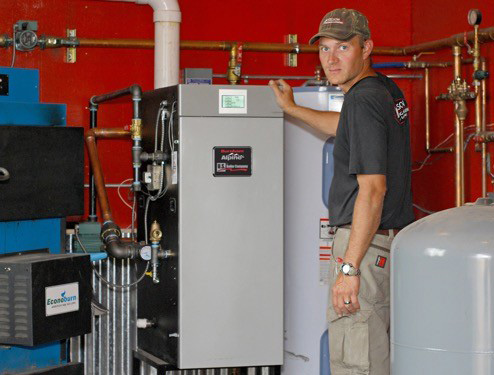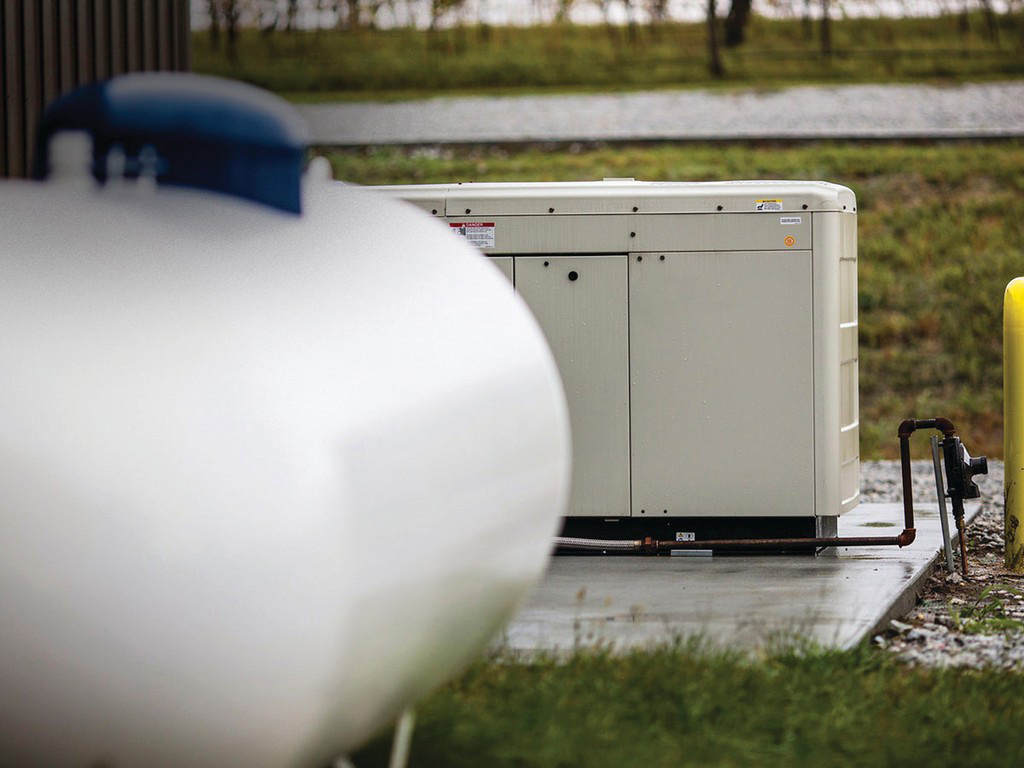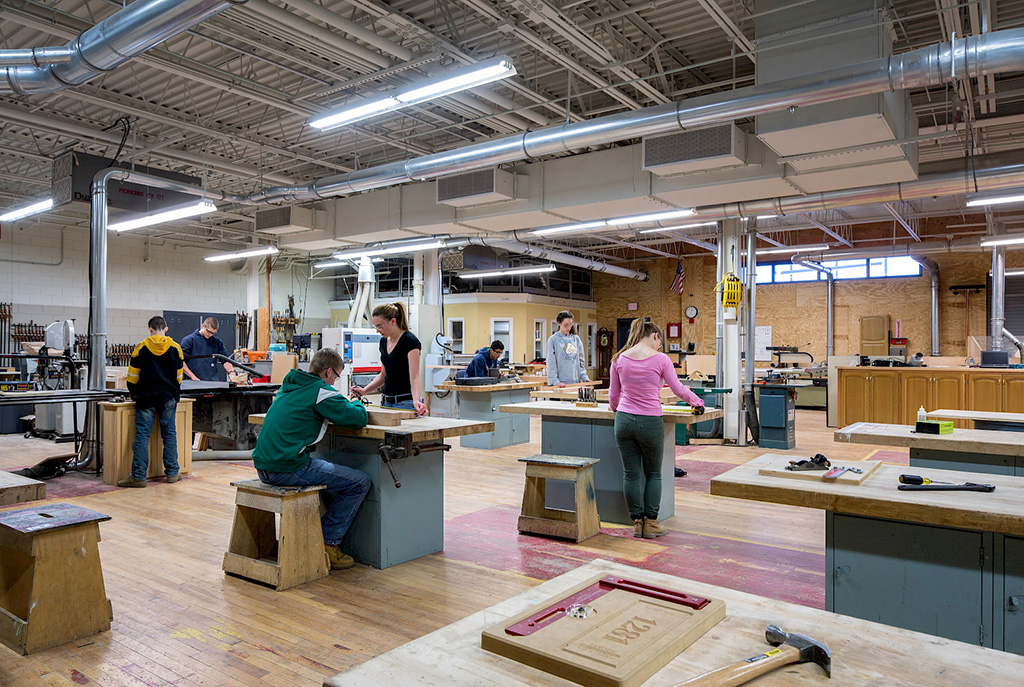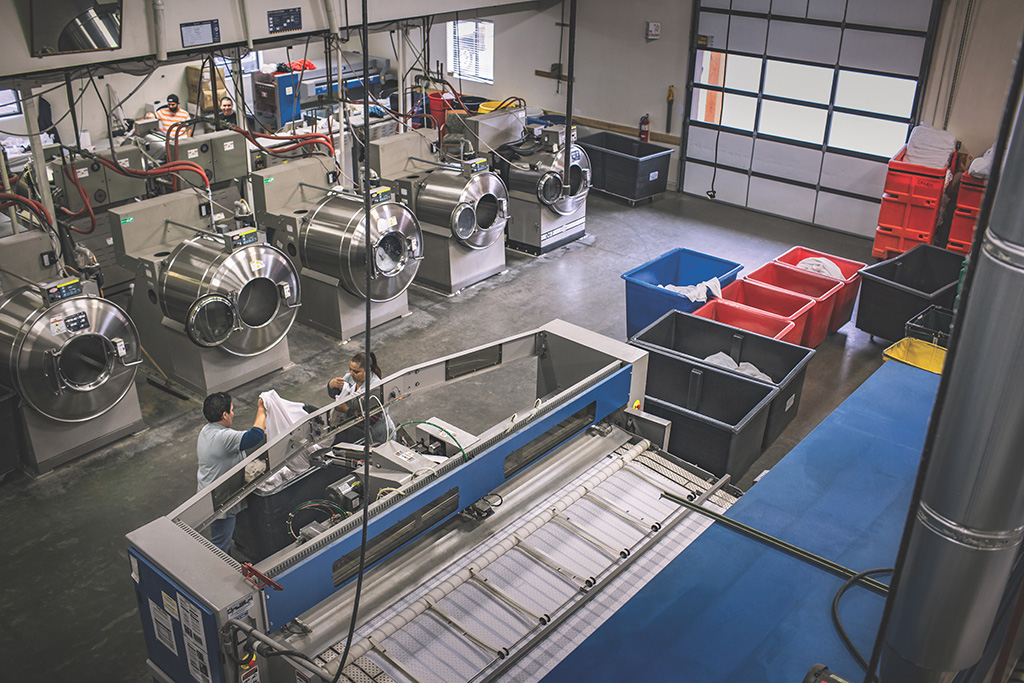
Photo courtesy of Propane Education & Research Council
Circumstances around businesses are increasingly uncertain. Yet, providing power and services should always be dependable. Using a site-based, clean, and abundant energy source means providing reliability for the structure and its occupants.
Creating Resilience by Design
Commercial buildings and the businesses they support are particularly vulnerable to natural disasters, power outages, and other unforeseen events. Severe weather, mandated downtimes, and other incidents can cause unexpected power outages. Planning for future challenges, both anticipated and unforeseen, is imperative to ensure that a building project will protect occupant safety and comfort. That means designing for resilience.
The electrical grid in the United States is a complex network that provides energy to millions of homes and businesses, putting it at the center of the nation’s economy. Nearly all aspects of commerce and industry depend on affordable and readily available sources of energy. However, the grid is vulnerable, with outages costing the U.S. economy approximately $150 billion each year1. The aging U.S. electrical grid was not designed to deal with the severity or frequency of extreme weather events and is vulnerable to outages and damage that may be caused by them. Over 70 percent of the grid is more than 25 years old and will need replacing in the coming decades2.
The leading cause of electric power outage events is extreme weather events, including coastal flooding, heat waves, ice storms, droughts, wildfires, and winds from severe storms. No part of the country is immune to natural disasters. Indeed, the five states with the most weather-related outages between 2000 and 2023, according to findings from Climate Central, stretch from coast to coast: Texas (210), Michigan (157), California (145), North Carolina (111), and Ohio (88)3. Within the past few years, snowstorms have caused widespread power outages in the Northeast, deadly hurricanes have ripped through the Gulf Coast, and wildfires and power outages have struck California. In 2022, California accounted for 24 percent of all U.S. power outages, through a combination of unplanned power outages and utility-initiated de-energization events called Public Safety Power Shutoff (PSPS) outages, which occur when there are potentially dangerous weather conditions in fire-prone areas4. During these events, power is proactively turned off to reduce the threat of wildfires.
On a day-to-day basis, businesses also experience increased price volatility, higher capacity charges to ensure electricity supply during peak periods, and replacement costs for failing energy infrastructure. These costs are often passed on to consumers. Additionally, a lack of transmission capacity to deliver the lowest-cost generation, known as grid congestion, costs consumers an estimated $20.8 billion in 20225. Meeting the power, space heating, water heating, lighting, and other critical needs of sparsely populated areas, buildings in extreme climates, or those located within rugged terrain can also be challenging. Energy efficiency and other methods of controlling operating costs are important, as is securing a power source for potential outages.
In areas where natural disasters occur, architects and building owners have discovered the value of designing and operating more durable commercial properties. Resilient building is about more than sturdiness: resilience provides the ability to function after or during an ongoing natural disaster or accidental power outage. As more and more businesses face the threat of property damage and power outages, it’s important for both essential and nonessential businesses to keep the lights on and serve their customers.
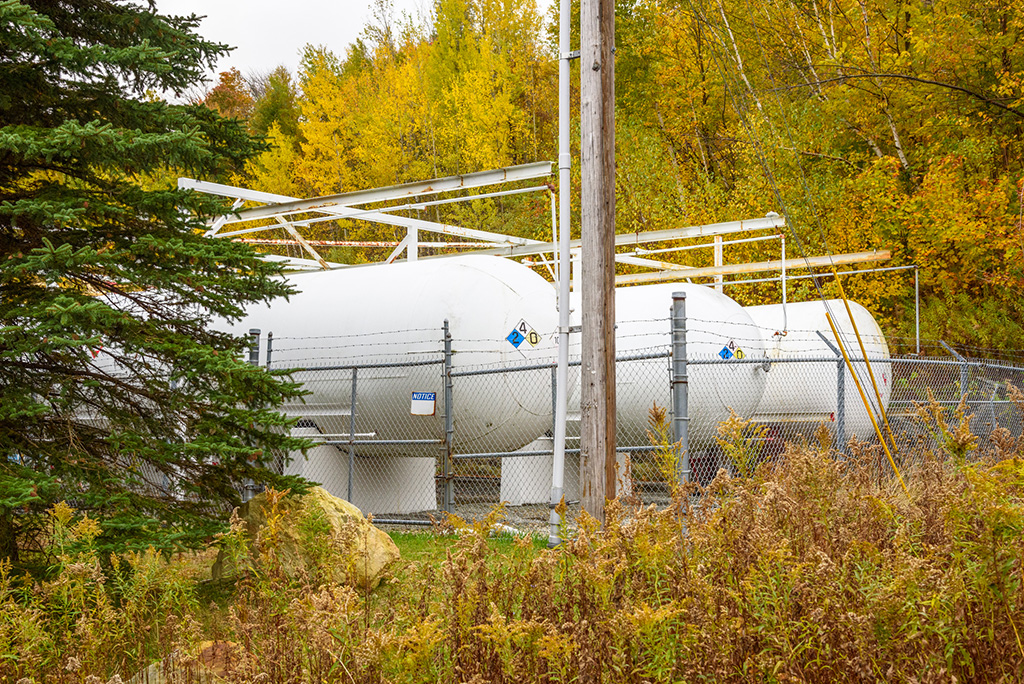
Photo: LaCasse Photography; courtesy of Propane Education & Research Council
Propane has demonstrated its resilience by performing in areas with sparse population, rugged terrain, and extreme climates. Creede School project in Mineral County, Colorado, designed and built by the Neenan Company, and powered by propane.
Answering the Call: The Role of Propane
A clean, reliable, domestically produced, abundant, and affordable energy solution exists to enable building resilience. Propane, sometimes known as liquefied petroleum gas, or LPG, is a gas normally compressed and stored as a liquid. It is nontoxic, colorless, and virtually odorless; an identifying odor is added to the finished product so that leaks can be detected. Propane is commonly used for space and water heating, for cooking, and as fuel for engine applications; its applications are rapidly growing due to new technology developments. Propane is also quickly expanding into commercial construction markets through innovations in commercial tank manufacturing and commercial distribution networks. Propane can now be used for any commercial building application that does not have access to natural gas or where it is cost-prohibitive to extend lines, including new construction, interior construction for new tenants, major renovations, and building efficiency upgrades.
Propane brings all the advantages of gas to buildings, at a competitive price, even if they are off the power grid or public utilities. The U.S. produces more than enough propane to meet demand and is the leading producer of propane. Despite sharp declines in oil prices, domestic propane production is expected to continue to grow rapidly, keeping downward pressure on average propane prices relative to oil prices. Because natural gas is delivered by a network of underground distribution and service pipelines, when deciding what areas to serve, natural gas companies consider the economic return on investment that is necessary to build out their network. Propane, on the other hand, is delivered by vehicles and stored on site in tanks, which allows for more flexibility. It also makes propane prices competitive even in low-density markets. Projects thought to be impossible or cost-prohibitive owing to the lack of access to natural gas are possible because of propane, and projects delayed by the need to construct pipelines can move forward right away with propane. And with the option of aboveground or underground storage tanks, propane professionals can install and connect building systems and other applications on the project team’s schedule. Propane also provides jobsite flexibility by providing gas energy for portable generators and temporary heaters.
For millions of Americans every day, propane continues to deliver what is most important to customers when choosing their energy: reliability. Even during extreme weather and natural disasters, propane reliably heats and powers homes, businesses, and farms independent of the electric grid. Propane is an approved clean fuel listed in the 1990 Clean Air Act. Substituting propane for other fuels such as gasoline and fuel oil is an economical and viable step toward cleaner air. Using propane reduces the greenhouse gas carbon dioxide and air pollutants like carbon monoxide and nitrogen oxide6.
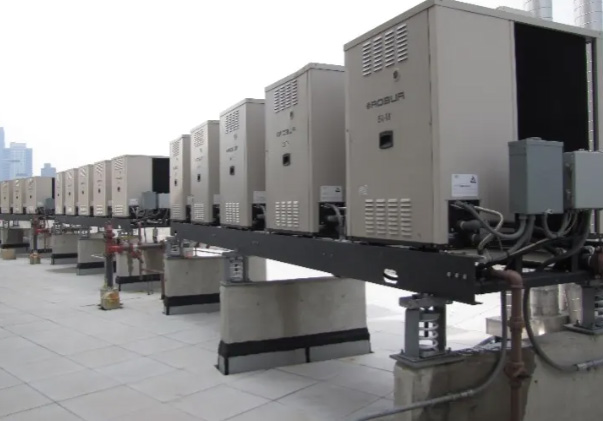
Photo courtesy of Propane Education & Research Council
Propane is quickly expanding into commercial construction markets through innovations in commercial tank manufacturing and commercial distribution networks, and can be used for any commercial building application, including cooling.
Developing Designs with Propane
There are three components to a commercial building’s propane infrastructure: storage, a distribution system, and optional components. Because of its flexibility, propane provides scalable solutions for small- to large-scale projects.
Propane storage tanks provide on-site propane storage for commercial building projects of any size, from the smallest commercial building to a sprawling resort or retail complex. This greatly increases the architect’s design flexibility. The fact that propane is stored locally in tanks provides additional flexibility for developers and owners. Propane can either be bought as needed for a project, stored in tanks on site, or stored off-site for future delivery. The smallest tank systems available range from 120 gallons to 2,000 gallons for spot energy needs. For larger projects, 18,000- and 30,000-gallon tanks are commonly used. Other storage tanks can hold as many as 120,000 gallons. One tank can be sized to serve a building’s energy needs, based on its total maximum load, measured in British thermal units (Btus). Alternately, multiple smaller tanks can be manifolded together.
Propane storage can be underground or aboveground. Tanks can be placed at multiple sites throughout a project, or one central tank can be used with gas piping running throughout the complex of commercial buildings. There are also several options for placing storage tanks. They can be fenced, buried, or landscaped according to the aesthetic, safety, and security needs of individual applications.
Propane distribution systems are like natural gas systems in that underground pipes deliver the propane to individual service points on buildings. Outside gas piping is buried according to locally applied codes and standards.
Optional components can help building owners manage their propane supply. A remote tank-monitoring system uses a wireless connection to send periodic reports of tank levels to the propane provider and the customer, which improves the efficiency of scheduled deliveries. A metered service arrangement allows multiple customers to share a single propane supply and be billed only for their usage.
Propane Expansion into Commercial Markets
Some commercial architects, particularly those in urban areas, are not familiar with the many benefits of designing with propane, including its versatility for heating, cooling, backup power, and water heating, or large-scale project deployment. Overcoming misconceptions allows architects to bring the solutions only propane provides. Some preconceived concerns include off-gassing and detection, unknown green building rating implications, and logistical challenges regarding propane’s storage and maintenance.
However, propane is quickly expanding into commercial construction markets through innovations in commercial tank manufacturing and commercial distribution networks. Commercial and industrial companies face the demand to adopt energy options that are reliable and affordable, while also meeting emissions standards. Propane provides a clean energy solution that delivers superior comfort, lower emissions and energy costs, and exceptional reliability for businesses. Energy trade-offs and life cycle costs are particularly intriguing propane advantages, as is the potential for fuel versatility in a building.

Photo courtesy of Propane Education & Research Council
Circumstances around businesses are increasingly uncertain. Yet, providing power and services should always be dependable. Using a site-based, clean, and abundant energy source means providing reliability for the structure and its occupants.
Creating Resilience by Design
Commercial buildings and the businesses they support are particularly vulnerable to natural disasters, power outages, and other unforeseen events. Severe weather, mandated downtimes, and other incidents can cause unexpected power outages. Planning for future challenges, both anticipated and unforeseen, is imperative to ensure that a building project will protect occupant safety and comfort. That means designing for resilience.
The electrical grid in the United States is a complex network that provides energy to millions of homes and businesses, putting it at the center of the nation’s economy. Nearly all aspects of commerce and industry depend on affordable and readily available sources of energy. However, the grid is vulnerable, with outages costing the U.S. economy approximately $150 billion each year1. The aging U.S. electrical grid was not designed to deal with the severity or frequency of extreme weather events and is vulnerable to outages and damage that may be caused by them. Over 70 percent of the grid is more than 25 years old and will need replacing in the coming decades2.
The leading cause of electric power outage events is extreme weather events, including coastal flooding, heat waves, ice storms, droughts, wildfires, and winds from severe storms. No part of the country is immune to natural disasters. Indeed, the five states with the most weather-related outages between 2000 and 2023, according to findings from Climate Central, stretch from coast to coast: Texas (210), Michigan (157), California (145), North Carolina (111), and Ohio (88)3. Within the past few years, snowstorms have caused widespread power outages in the Northeast, deadly hurricanes have ripped through the Gulf Coast, and wildfires and power outages have struck California. In 2022, California accounted for 24 percent of all U.S. power outages, through a combination of unplanned power outages and utility-initiated de-energization events called Public Safety Power Shutoff (PSPS) outages, which occur when there are potentially dangerous weather conditions in fire-prone areas4. During these events, power is proactively turned off to reduce the threat of wildfires.
On a day-to-day basis, businesses also experience increased price volatility, higher capacity charges to ensure electricity supply during peak periods, and replacement costs for failing energy infrastructure. These costs are often passed on to consumers. Additionally, a lack of transmission capacity to deliver the lowest-cost generation, known as grid congestion, costs consumers an estimated $20.8 billion in 20225. Meeting the power, space heating, water heating, lighting, and other critical needs of sparsely populated areas, buildings in extreme climates, or those located within rugged terrain can also be challenging. Energy efficiency and other methods of controlling operating costs are important, as is securing a power source for potential outages.
In areas where natural disasters occur, architects and building owners have discovered the value of designing and operating more durable commercial properties. Resilient building is about more than sturdiness: resilience provides the ability to function after or during an ongoing natural disaster or accidental power outage. As more and more businesses face the threat of property damage and power outages, it’s important for both essential and nonessential businesses to keep the lights on and serve their customers.

Photo: LaCasse Photography; courtesy of Propane Education & Research Council
Propane has demonstrated its resilience by performing in areas with sparse population, rugged terrain, and extreme climates. Creede School project in Mineral County, Colorado, designed and built by the Neenan Company, and powered by propane.
Answering the Call: The Role of Propane
A clean, reliable, domestically produced, abundant, and affordable energy solution exists to enable building resilience. Propane, sometimes known as liquefied petroleum gas, or LPG, is a gas normally compressed and stored as a liquid. It is nontoxic, colorless, and virtually odorless; an identifying odor is added to the finished product so that leaks can be detected. Propane is commonly used for space and water heating, for cooking, and as fuel for engine applications; its applications are rapidly growing due to new technology developments. Propane is also quickly expanding into commercial construction markets through innovations in commercial tank manufacturing and commercial distribution networks. Propane can now be used for any commercial building application that does not have access to natural gas or where it is cost-prohibitive to extend lines, including new construction, interior construction for new tenants, major renovations, and building efficiency upgrades.
Propane brings all the advantages of gas to buildings, at a competitive price, even if they are off the power grid or public utilities. The U.S. produces more than enough propane to meet demand and is the leading producer of propane. Despite sharp declines in oil prices, domestic propane production is expected to continue to grow rapidly, keeping downward pressure on average propane prices relative to oil prices. Because natural gas is delivered by a network of underground distribution and service pipelines, when deciding what areas to serve, natural gas companies consider the economic return on investment that is necessary to build out their network. Propane, on the other hand, is delivered by vehicles and stored on site in tanks, which allows for more flexibility. It also makes propane prices competitive even in low-density markets. Projects thought to be impossible or cost-prohibitive owing to the lack of access to natural gas are possible because of propane, and projects delayed by the need to construct pipelines can move forward right away with propane. And with the option of aboveground or underground storage tanks, propane professionals can install and connect building systems and other applications on the project team’s schedule. Propane also provides jobsite flexibility by providing gas energy for portable generators and temporary heaters.
For millions of Americans every day, propane continues to deliver what is most important to customers when choosing their energy: reliability. Even during extreme weather and natural disasters, propane reliably heats and powers homes, businesses, and farms independent of the electric grid. Propane is an approved clean fuel listed in the 1990 Clean Air Act. Substituting propane for other fuels such as gasoline and fuel oil is an economical and viable step toward cleaner air. Using propane reduces the greenhouse gas carbon dioxide and air pollutants like carbon monoxide and nitrogen oxide6.

Photo courtesy of Propane Education & Research Council
Propane is quickly expanding into commercial construction markets through innovations in commercial tank manufacturing and commercial distribution networks, and can be used for any commercial building application, including cooling.
Developing Designs with Propane
There are three components to a commercial building’s propane infrastructure: storage, a distribution system, and optional components. Because of its flexibility, propane provides scalable solutions for small- to large-scale projects.
Propane storage tanks provide on-site propane storage for commercial building projects of any size, from the smallest commercial building to a sprawling resort or retail complex. This greatly increases the architect’s design flexibility. The fact that propane is stored locally in tanks provides additional flexibility for developers and owners. Propane can either be bought as needed for a project, stored in tanks on site, or stored off-site for future delivery. The smallest tank systems available range from 120 gallons to 2,000 gallons for spot energy needs. For larger projects, 18,000- and 30,000-gallon tanks are commonly used. Other storage tanks can hold as many as 120,000 gallons. One tank can be sized to serve a building’s energy needs, based on its total maximum load, measured in British thermal units (Btus). Alternately, multiple smaller tanks can be manifolded together.
Propane storage can be underground or aboveground. Tanks can be placed at multiple sites throughout a project, or one central tank can be used with gas piping running throughout the complex of commercial buildings. There are also several options for placing storage tanks. They can be fenced, buried, or landscaped according to the aesthetic, safety, and security needs of individual applications.
Propane distribution systems are like natural gas systems in that underground pipes deliver the propane to individual service points on buildings. Outside gas piping is buried according to locally applied codes and standards.
Optional components can help building owners manage their propane supply. A remote tank-monitoring system uses a wireless connection to send periodic reports of tank levels to the propane provider and the customer, which improves the efficiency of scheduled deliveries. A metered service arrangement allows multiple customers to share a single propane supply and be billed only for their usage.
Propane Expansion into Commercial Markets
Some commercial architects, particularly those in urban areas, are not familiar with the many benefits of designing with propane, including its versatility for heating, cooling, backup power, and water heating, or large-scale project deployment. Overcoming misconceptions allows architects to bring the solutions only propane provides. Some preconceived concerns include off-gassing and detection, unknown green building rating implications, and logistical challenges regarding propane’s storage and maintenance.
However, propane is quickly expanding into commercial construction markets through innovations in commercial tank manufacturing and commercial distribution networks. Commercial and industrial companies face the demand to adopt energy options that are reliable and affordable, while also meeting emissions standards. Propane provides a clean energy solution that delivers superior comfort, lower emissions and energy costs, and exceptional reliability for businesses. Energy trade-offs and life cycle costs are particularly intriguing propane advantages, as is the potential for fuel versatility in a building.
Design in Action: Propane and Large Commercial Projects
Propane is used in large projects, such as warehouse facilities and schools, for reliable, cost-efficient, and sustainable energy. Though familiar as a source of backup power, propane-powered systems play an important role in offering efficient performance and service.
Water Heating
In grand-scale applications, commercial propane furnaces and water heaters are reliable options for large buildings such as schools and warehouses with a high demand for energy, making propane the most cost-effective fuel choice.
Propane tankless water heaters achieve energy factors as high as 98 percent and can be strategically combined into high-capacity banks. These tankless rack systems can vent outside using a common venting system and can be assembled off-site, increasing the speed and ease of installation. They can also rotate the firing sequence of the water heaters, improving the system’s efficiency and life span.
Furthermore, selecting propane tankless water heating provides flexible installation. Smaller tankless water heaters can serve unique, defined areas, such as restrooms and science labs. For example, a large building, such as a school, may combine local propane tankless water heaters near rooms such as bathrooms and science labs with larger commercial storage tank water heaters near the cafeteria. Storage tank water heaters can supply domestic hot water to meet consistently high demand from an area like a kitchen or showers, while tankless units support the use of low-flow fixtures, offering a turndown ratio (the ratio between the maximum and minimum operating capacity of a device) of 20:1 for more precise and efficient response to hot-water demands.
Space Conditioning Heating large campuses, such as warehouses and schools, is an economic, environmental, and safety challenge, as the sheer size of such buildings makes them difficult to heat. If they are not heated efficiently, money and energy are wasted.
Maintaining proper conditioning and power in a warehouse environment is important because of the value of items stored there, particularly perishables such as refrigerated and frozen items. Providing affordable heating and cooling for cavernous warehouses or big- box stores might seem daunting, but with systems including propane-powered heating and cooling, high-capacity water heaters, and backup generators, large buildings can keep all systems running comfortably and efficiently around the clock.
Floor-level air-rotation systems are used for heating facilities up to 150,000 square feet and cooling facilities as large as 100,000 square feet. Propane combustion provides thermal energy to the heat exchanger, while propane glycol is used for cooling purposes. These systems eliminate the need for multiple rooftop units, roof penetrations, and ductwork, and they can be completely operational in a day or two.
Switching to propane-powered cooling systems significantly reduces site electricity requirements, providing cost savings, environmental benefits, and grid relief. While not as well known, propane cooling is a proven technology that has been used for decades, operating like traditional systems but using propane to power a compressor or ignite the gas burner. Available in sizes from 5 to 400 tons, these cooling systems provide superior and efficient performance and serve diverse needs, including comfort conditioning, process cooling, dehumidification, medium-temperature refrigeration, and extreme ambient operation.
Solutions for Schools
In schools, administrators have enough to worry about with large student populations and ever-tightening budgets; the last thing about which they need to have concern is the reliability of their heating system. Schools can incorporate propane to provide safety for students and power during an outage. Schools heated with propane can also cut down on utility bills while utilizing trustworthy systems that ensure the heating won’t fail at an inopportune time. For many schools and institutions, high-efficiency propane boilers are the most cost-effective heating option. High-efficiency propane combination space- and water-heating systems can provide both hot water and hydronic heat, as well as supplemental heating for pools when needed.
Providing Power During the Unforeseen
An essential advantage of propane is that it is locally stored and readily available in the event of a catastrophic failure of the energy grid. In addition to providing site-stored energy for conditioning or heating applications, propane can fuel a standby generator, allowing a business to stay open. A reliable propane standby generator is a key part of resilient design, allowing a business to resist the hazards brought on by major disasters and keep its employees engaged and productive during what would otherwise be downtime. Businesses can also continue to provide necessary services and products to customers and generally reduce the magnitude or duration of a disruptive event.
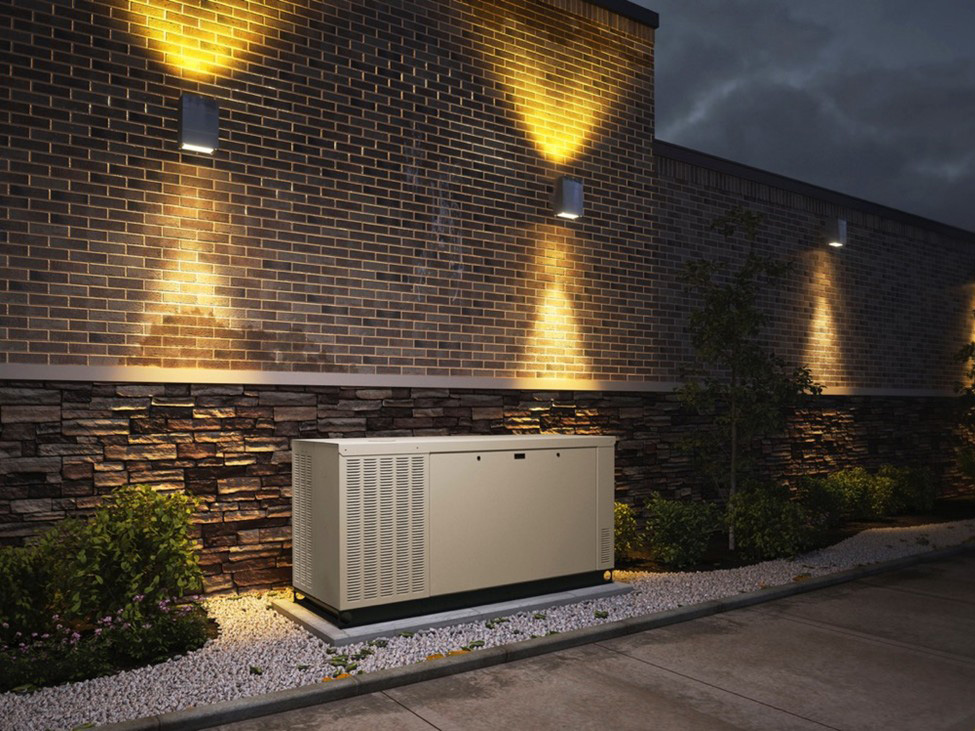
Photo courtesy of Propane Education & Research Council
Propane is locally stored and readily available in the event of a catastrophic grid failure or other energy outage.
In a warehouse or manufacturing environment, even small power outages can lead to costly downtime or damaged inventory. Standby generators can provide backup power for heating and cooling systems, and lighting, keeping the facility open and ensuring customers get their products on time.
Keeping educational buildings lit and heated is just as important because they often are used as shelters during emergencies, supplying electricity, heat, air conditioning, and hot water. On-site generators fueled by propane allow institutions to stay open during and after hurricanes and severe storms that bring widespread power outages. Propane is a site-stored energy source that is less likely to fail or be interrupted in a storm or grid outage, helping to maintain lighting, heating, air conditioning, and refrigeration.
Although propane is perhaps best known for protecting homes, hospitals, and critical infrastructure with standby generators, propane companies are equipped to quickly respond to other emergency energy needs. For example, propane companies frequently work with the Federal Emergency Management Agency (FEMA) or other government contractors to provide heat for temporary structures, fuel for mobile kitchens, and hot water for mobile showers and laundry facilities. During the 2020 COVID-19 pandemic, propane provided critical energy for temporary overflow hospitals and testing sites.
The response during these emergencies is likely to involve federal, state, or local governments; equipment vendors and rental facilities; disaster recovery and mitigation contractors; and insurance companies. Partnering with these responders, propane companies can consult on tank sizing options, safe placement, and permitting, and they can supply and install the equipment needed to connect the propane fuel source to heaters or other propane-powered equipment.
Smart Design and Propane
For occupant health and wellness, as well as profitability, businesses must stay well-lit, conditioned, and functioning. Propane can help solve numerous design challenges in commercial buildings, including power, hot-water needs for bathrooms, kitchens, laundry, or landscape, heating, fireplaces, and propane elements in outdoor-use spaces, like heaters, kitchens, or pools. Using propane as an energy source keeps all these essential systems running in case of power outages, allowing businesses to preserve uninterrupted function.
Propane Applications: Tankless Propane Water Heaters
Water heating in retail, restaurant, and hospitality businesses is important, as a steady supply of hot water is necessary for cooking, dishwashing, laundry, and restrooms. Hot water is not only a safety requirement to reduce disease transmission but is also important for guest comfort in hotel rooms and spa facilities, where hot water is needed for showering, bathing, and spa treatments.
Water-heating energy represents 5 percent of all energy use in commercial buildings7. However, of all commercial buildings, just six building types—lodging, healthcare, retail, education, food service, and office buildings—make up 85 percent of total commercial building water-heating energy consumption. Therefore, energy efficiency efforts focused on these specific building types can yield significant savings.
In low-demand scenarios such as retail, where water heating is probably needed only for a sink or two, a single propane tankless water heater unit installed near the point of use reduces delivery time and standby heat loss. Tankless units also preserve valuable square footage because they have a small installation footprint compared with traditional tank water heaters, which are usually installed in a utility closet or a boiler room. With their compact size, tankless water heaters save roughly 12 square feet of floor space.
In high-demand water-heating scenarios such as restaurants and hotels, having multiple propane tankless water heaters combined in an array offers a solution that saves space and efficiently meets fluctuating hot-water demands. These tankless racks create redundancy, so the hot-water supply will continue even if one unit is out of commission. Tankless water heaters used in commercial applications offer economical, on-demand, endless hot water, and they can be installed inside or outside, depending on the climate, providing much-desired design flexibility.
Retail, restaurant, and hotel business clients are acutely aware of the need to maximize space within the floor plan to better accommodate merchandise, patrons, and guests. Incorporating propane-fueled appliances and systems can increase usable space in buildings.
Propane Applications: Commercial Radiant Heat
Propane-powered snow melt systems provide a safe, cost-effective solution, reducing labor, minimizing liability, and eliminating the need for harmful ice melt chemicals. Snow melt systems are straightforward and very similar in design to radiant floor heating in a building. However, they do require upfront planning and careful consideration of the site, heat source, sizing, and piping. In-ground sensors detect snow or ice, signaling pipes embedded in the ground to circulate a glycol solution that heats the surface and melts snow and ice. Propane boilers serve as an efficient component in snow melt systems. Smaller, high-efficiency modulating-condensing boilers are widely used. A zoned system helps downsize the heating source; for example, a 500,000 Btu snowmelt system can be broken up into five 100,000 Btu boilers to melt different areas independently of the others. Onboard controls can be used to easily link multiple boilers together, then control the boiler, or multiple smaller boilers, to keep the temperature low for snowmelt systems, which only need to run at 110-120˚F. Using multiple smaller boilers instead of a single larger boiler can provide much greater turndown ratios, redundancy, and more flexibility in heating capacity.
More innovative heat sources are those that capture waste heat, which is then used to melt snow and ice. Waste heat could come from a cooling tower, a compressor for a large freezer, or a building’s steam system. Additionally, a combined heat and power system (CHPS) provides stable power from an engine or turbine and uses the waste heat for water heating and snowmelt.
Propane-powered snow melt systems are popular in regions of the country that receive significant winter weather. Project types where commercial builders or property owners should specify a snow melt system for vehicle and pedestrian safety are hotels and restaurants, ski resorts, universities, and parking garages. In addition, snow melt systems are also critical at hospitals, clinics, and assisted living facilities for access ramps and helipads so patients can safely be transported into the building.
Propane Applications: Commercial Propane Furnaces
Commercial gas furnaces are self-contained units that supply heated air to condition a wide variety of buildings. Many commercial HVAC designs use commonly available propane furnaces that efficiently and effectively heat commercial spaces.
In retail buildings, an efficient rooftop furnace can quickly and cost-effectively heat a small or midsize building, moving the unit outdoors and freeing up square footage within the store. In these types of buildings, packaged rooftop units (RTUs) are air conditioners with a propane or natural gas heating section. High-efficiency propane furnaces, generally those with efficiency levels above 90 percent annualized fuel utilization efficiency (AFUE), capture additional heat from the combustion gases and use this to increase the heat transfer of the furnace for greater efficiency.
In restaurants, a rooftop furnace can quickly and cost-effectively heat the space, and it can serve two different zones for the kitchen and seating area. Newer units have multiple stages and microprocessors to reduce energy costs, along with variable airflow to meet diverse heating loads.
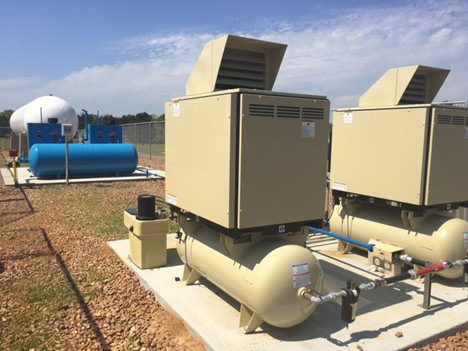
Photo courtesy of Propane Education & Research Council
Combining propane systems, such as boilers that provide hot water and space heating, or vaporizers, which increase the performance capacity of the system, offers cost savings and redundancy.
Propane furnaces offer designers great flexibility in both the type and capacity of the equipment, which makes them a good fit for many different commercial buildings. Smaller residential-scale units can range in capacity from 44,000 Btu/h up to 180,000 Btu/h, with efficiency levels of 80–98.5 percent AFUE. Larger units with capacities greater than 225,000 Btu/h are measured by their thermal efficiency and can reach capacities greater than 1 million Btu/h.
A critical feature of these furnaces is their ability to condition different zones of a building. This allows the use of multiple, smaller furnaces, often packaged as RTUs, to be installed to meet the heating needs of just one part of a building. Zoning offers improved efficiency and temperature control in the space, as well as modularity that can simplify installation and maintenance.
Propane Applications: Combined Heat and Power (CHP)
Faced with rising electricity costs and frequent outages, commercial and industrial facilities are turning to propane combined heat and power (CHP) systems for an affordable and reliable energy solution. These CHP systems use propane-powered engines to generate on-site electricity while capturing thermal energy for heating and hot water. Excess electricity can be sent back to the grid, ensuring dependable heat and power without relying on the electric grid.
Cost-effective and environmentally friendly CHP systems enhance energy efficiency, minimize waste heat and harmful emissions, and deliver electricity and thermal energy. CHP is used in over 4,400 facilities across the U.S., including factories, hospitals, colleges, and commercial buildings. Because they operate efficiently, CHP systems consume less fuel to provide the same energy services. This efficient energy generation also reduces various types of emissions, including greenhouse gases (GHGs) such as carbon, criteria pollutants, and hazardous air pollutants. In addition, it can complement renewable resources such as solar and wind and allow facilities to utilize these intermittent renewable resources while maintaining reliability.
Propane Applications: Boilers
Propane boilers offer value in commercial building applications by providing both space-heating and hot-water needs with high efficiency levels, via reliable systems offering versatile designs. Commercial propane boilers are used to generate hot water or steam for various building applications. They can be categorized as either condensing or noncondensing types, with condensing units having higher efficiency ratings.
In space-heating applications, these boilers can work in conjunction with heating delivery systems. For hot-water supply, propane boilers can provide high volumes of hot water for domestic consumption as well as related applications like laundry, typically with the same boiler that provides space heating. The ability to supply domestic hot water in addition to space heating makes propane boilers ideal candidates for commercial installations. Because only one system must be designed, the design process and system layouts are simplified
Propane boilers are available in a wide range of heating capacities to support many applications, with inputs reaching as high as 8,660,000 Btu/h. Propane offers both the smallest input and largest output rates, when compared with heating oil boilers, to suit different applications. Multiple boilers can also be banked together for larger system capacities, while offering a redundant system design.
Propane Applications: Vaporizers
Vaporizers offer several advantages. First, they increase the performance capacity of the propane system without installing larger tanks. Additionally, vaporizers are a space-saving tactic. A vaporizer is essentially a boiler that uses heat to aid the natural vaporization process of propane from liquid to gas. The result is an increase in the Btu delivery capacity of the system without a corresponding increase in the size or number of the propane storage tanks, which may not be possible where space is limited.
Propane Applications: Outdoor Dining and Use
Unlike systems that run on natural gas or grid electricity, propane systems are flexible and scalable, allowing businesses to quickly adapt outdoor or alternate spaces for short- or long-term needs. Outdoor amenities can be used to increase the usable footprint of a restaurant, maximize the curb appeal of a building entrance, or turn a patio into a year-round amenity. Propane fireplaces, fire pits, and patio heaters extend the outdoor dining season by raising the outdoor air temperature to comfortable levels. For restaurants, hotels, and other hospitality businesses, turning outdoor spaces into usable square footage can provide revenue for an additional 12–16 weeks of the year.
For outdoor pools, propane-powered pool heaters offer a cost-effective solution. They are highly efficient and are proven to lower energy costs compared to other heating sources. Propane heats pools and spas more quickly than electric heat pumps, keeping the water at the perfect temperature. Propane’s versatility and efficiency ensure that a pool keeps a consistent temperature during cooler seasons or in regions with fluctuating weather.
Conclusion
Propane provides affordable, reliable, and versatile energy for commercial needs. Commercial operations have a unique set of needs for their businesses and customers: from hotels to hospitals, restaurants to manufacturing, schools to data centers, critical systems must be operational to provide continued production, service, and care. Propane systems provide the energy needed to keep the lights on and operations running and reduce the demand on the electric grid. Propane provides a clean energy solution that delivers superior comfort, lower emissions and energy costs, and exceptional reliability for businesses.
End Notes
- “Department of Energy Report Explores U.S. Advanced Small Modular Reactors to Boost Grid Resilience.” Office of Nuclear Energy. U.S. Department of Energy. January 25, 2018. Accessed June 5, 2025.
- “How Renewable Energy Can Make the Power Grid More Reliable and Address Risks to Electricity Infrastructure.” Joint Economic Committee. January 19, 2024. Accessed June 5, 2025.
- “Weather-related Power Outages Rising.” Climate Matters. Climate Central. April 24, 2024. Accessed June 4, 2024.
- “Renewable Energy Mandates Increase Chances of Major Blackouts.” American Energy Alliance. March 18, 2024. Accessed June 24, 2025.
- Doying, Richard; Goggin, Michael; and Sherman, Abby. “Transmission Congestion Costs Rise Again in U.S. RTOS.” Grid Strategies. July 2023. Accessed June 5, 2025.
- Alternative Fuels Data Center: Propane. U.S. Department of Energy. “About Propane.” Western Propane Gas Association. Accessed June 24, 2025.
- 2018 Commercial Buildings Energy Consumption Survey. December 2022. U.S. Energy Information Administration. Updated June 29, 2023. Accessed June 11, 2025.
Amanda Voss, MPP, is an author, editor, and policy analyst. Writing for multiple publications, she has also served as the managing editor for Energy Design Update.




